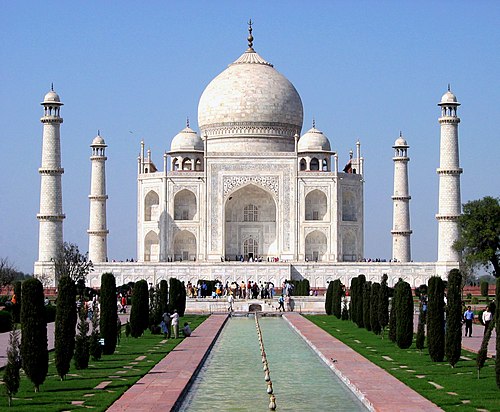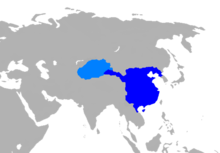Portal:Asia

 Asia (/ˈeɪʒə/ ⓘ AY-zhə, UK also /ˈeɪʃə/ AY-shə) is the largest continent in the world by both land area and population. It covers an area of more than 44 million square kilometers, about 30% of Earth's total land area and 8% of Earth's total surface area. The continent, which has long been home to the majority of the human population, was the site of many of the first civilizations. Its 4.7 billion people constitute roughly 60% of the world's population. Asia shares the landmass of Eurasia with Europe, and of Afro-Eurasia with both Europe and Africa. In general terms, it is bounded on the east by the Pacific Ocean, on the south by the Indian Ocean, and on the north by the Arctic Ocean. The border of Asia with Europe is a historical and cultural construct, as there is no clear physical and geographical separation between them. It is somewhat arbitrary and has moved since its first conception in classical antiquity. The division of Eurasia into two continents reflects East–West cultural, linguistic, and ethnic differences, some of which vary on a spectrum rather than with a sharp dividing line. A commonly accepted division places Asia to the east of the Suez Canal separating it from Africa; and to the east of the Turkish Straits, the Ural Mountains and Ural River, and to the south of the Caucasus Mountains and the Caspian and Black seas, separating it from Europe. China and India traded places as the largest economies in the world from 1 to 1800 CE. China was a major economic power for much of recorded history, with the highest GDP per capita until 1500. The Silk Road became the main east–west trading route in the Asian hinterlands while the Straits of Malacca stood as a major sea route. Asia has exhibited economic dynamism as well as robust population growth during the 20th century, but overall population growth has since fallen. Asia was the birthplace of most of the world's mainstream religions including Hinduism, Zoroastrianism, Judaism, Jainism, Buddhism, Confucianism, Taoism, Christianity, Islam, Sikhism, as well as many other religions. (Full article...) Featured articleThe Han dynasty (UK: /ˈhæn/, US: /ˈhɑːn/; traditional Chinese: 漢朝; simplified Chinese: 汉朝; pinyin: Hàncháo) was an imperial dynasty of China (202 BC – 9 AD, 25–220 AD), established by Liu Bang and ruled by the House of Liu. The dynasty was preceded by the short-lived Qin dynasty (221–207 BC) and a warring interregnum known as the Chu–Han contention (206–202 BC), and it was succeeded by the Three Kingdoms period (220–280 AD). The dynasty was briefly interrupted by the Xin dynasty (9–23 AD) established by usurping regent Wang Mang, and is thus separated into two periods—the Western Han (202 BC – 9 AD) and the Eastern Han (25–220 AD). Spanning over four centuries, the Han dynasty is considered a golden age in Chinese history, and it has influenced the identity of the Chinese civilization ever since. Modern China's majority ethnic group refer to themselves as the "Han people" or "Han Chinese". The spoken Sinitic language and written Chinese are referred to respectively as the "Han language" and "Han characters". The emperor was at the pinnacle of Han society. He presided over the Han government but shared power with both the nobility and appointed ministers who came largely from the scholarly gentry class. The Han Empire was divided into areas directly controlled by the central government called commanderies, as well as a number of semi-autonomous kingdoms. These kingdoms gradually lost all vestiges of their independence, particularly following the Rebellion of the Seven States. From the reign of Emperor Wu (r. 141–87 BC) onward, the Chinese court officially sponsored Confucianism in education and court politics, synthesized with the cosmology of later scholars such as Dong Zhongshu. This policy endured until the fall of the Qing dynasty in 1912. (Full article...)Selected Country Qatar, officially the State of Qatar, is a country in West Asia. It occupies the Qatar Peninsula on the northeastern coast of the Arabian Peninsula in the Middle East; it shares its sole land border with Saudi Arabia to the south, with the rest of its territory surrounded by the Persian Gulf. The Gulf of Bahrain, an inlet of the Persian Gulf, separates Qatar from nearby Bahrain. The capital is Doha, home to over 80% of the country's inhabitants, and the land area is mostly made up of flat, low-lying desert. Qatar has been ruled as a hereditary monarchy by the House of Thani since Mohammed bin Thani signed "an agreement, not a formal treaty" with Britain in 1868 that recognised its separate status. Following Ottoman rule, Qatar became a British protectorate in 1916 and gained independence in 1971. The current emir is Tamim bin Hamad Al Thani, who holds nearly all executive, legislative, and judicial authority in autocratic manner under the Constitution of Qatar. He appoints the prime minister and cabinet. The partially-elected Consultative Assembly can block legislation and has a limited ability to dismiss ministers. (Full article...)Featured biographyGeneral Raden Oerip Soemohardjo ([urɪp sumɔˈhardʒɔ]; Perfected Spelling: Raden Urip Sumoharjo, 22 February 1893 – 17 November 1948) was an Indonesian general, the first chief of staff of the Indonesian National Armed Forces, and the interim Commander of the Indonesian National Armed Forces. He received several awards from the Indonesian government, including the title National Hero of Indonesia in 1964. He was also a recognized Catholic by the Holy See, by which Pope Paul VI dedicated a memorial chalice for him with a Latin inscription acknowledging his legacy. Born in Purworejo, Dutch East Indies, Raden Oerip Soemohardjo exhibited leadership skills from an early age. As his parents wanted him to become a regent, after elementary school Oerip was sent to the School for Native Government Employees in Magelang. His mother died during his second year at the school, and Oerip left to undertake military training in Meester Cornelis, Batavia (modern-day Jatinegara, Jakarta). Upon graduating in 1914, he became a lieutenant in the Royal Netherlands East Indies Army; during almost 25 years of service he was stationed on three different islands and promoted several times, eventually becoming the highest-ranking Native officer in the country. (Full article...)General imagesThe following are images from various Asia-related articles on Wikipedia. Featured picture Credit: Sandeep Dhirad The Taj Mahal in Agra, India, was commissioned by the 17th century Mughal Emperor Shah Jahan, as a mausoleum for his Persian wife, Mumtaz Mahal. Built over a period of 23 years, it is a masterpiece of Mughal architecture, featuring the finest materials from all over India and Asia. Its gleaming facade is clad in white marble from Rajasthan and inlaid with 28 types of precious and semi-precious stones. It is a UNESCO World Heritage Site considered to be of "outstanding universal value".
Did you know...
Updated: 6:33, 14 February 2024 In the news
Related portalsMajor Religions in Asia Middle East Central Asia and Surroundings Indian Subcontinent Southeast Asia East Asia Selected panorama
The Hajj is an annual Islamic pilgrimage to Mecca, Saudi Arabia, the holiest city for Muslims, and a mandatory religious duty for Muslims that must be carried out at least once in their lifetime by all adult Muslims who are physically and financially capable of undertaking the journey, and can support their family during their absence. TopicsCategoriesAssociated WikimediaThe following Wikimedia Foundation sister projects provide more on this subject:
More portalsShortcuts to this page: Asia portal • P:ASIA Purge server cache |






























































































